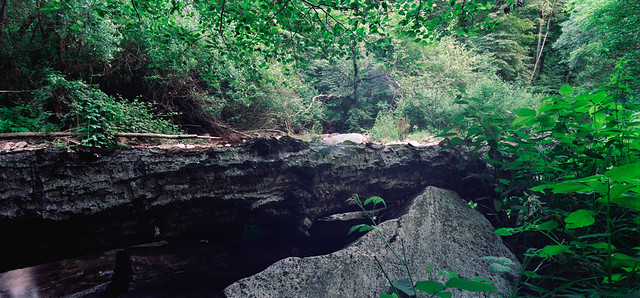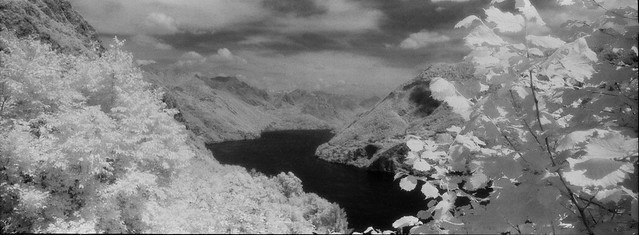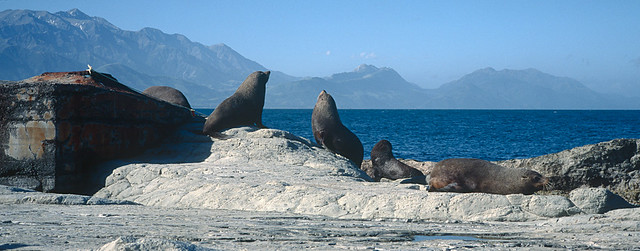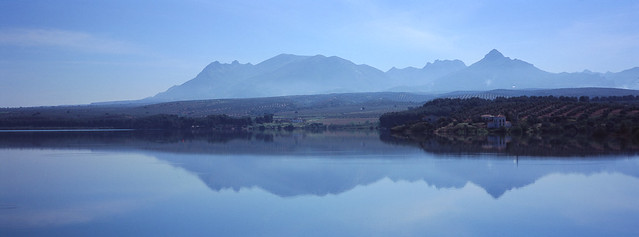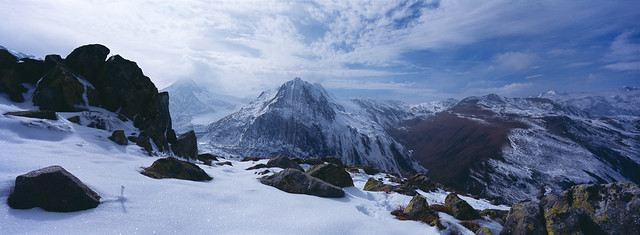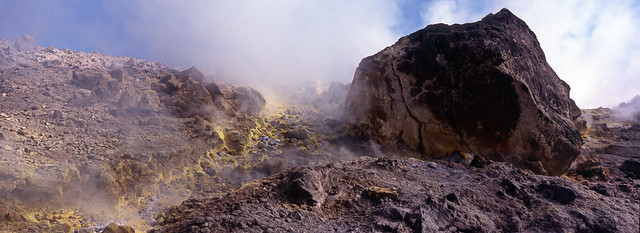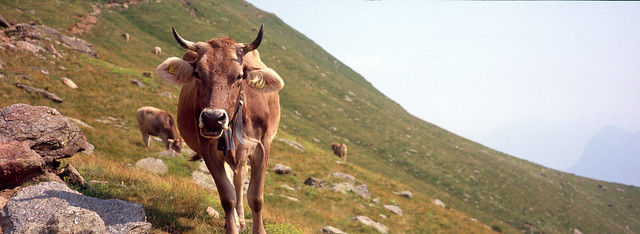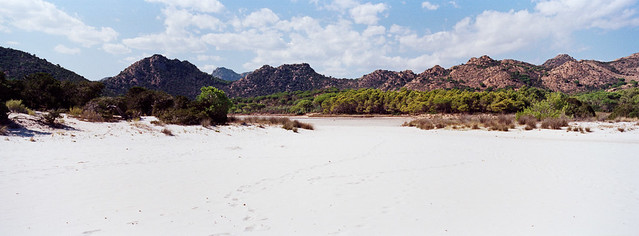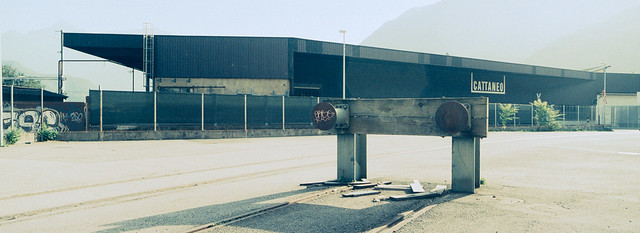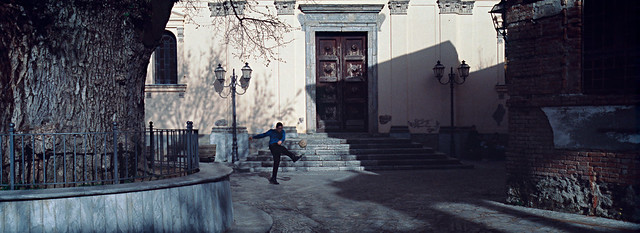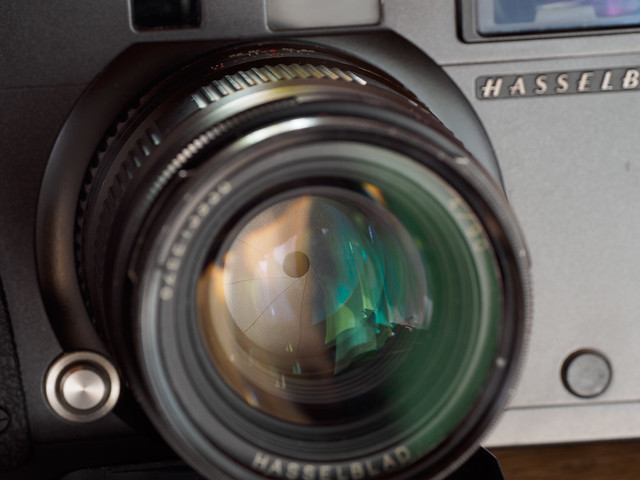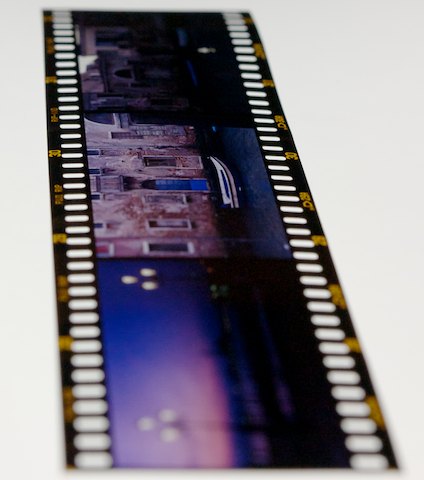I acquired my first Hasselblad XPan in the spring of 2000. So maybe it’s about time to write a few words about it.
My interest in so-called panoramic photography began in the mid-1990s, when I was professionally involved in the emerging multimedia world. In particular I adopted very early versions of Apple’s QuickTime VR technology to generate immersive walkthroughs of various scenes. As time was generally limited, initially I used an Apple QuickTake 200 camera to generate content (640Kpx images, approximately 30 per set of 4 very expensive lithium AA batteries), then experimented with Polaroid instant slide film. At some point I realised that it could be interesting to unwrap the 360 QTVR files to create widescreen stills. I used these in creating a couple of CD sleeves, which was a sideline of mine at the time, and in personal work. So when the Hasselblad XPan appeared on the scene in late 1998, I was fully primed.
2000: Lago di Lugano, infrared.
It was another year or so before I could actually afford it, but by then end of 2000 I had the camera and all three lenses, and took them with me on a 5 week trek around New Zealand - which later turned out to be the spiritual home of the XPan 😊.
The same kit travelled with me to Canada and the USA, to Spain, Iceland, Ireland, Greece and Italy, before finally setting off on a tour of Svalbard by yacht in 2010. A couple of days into the trip, when distracted from photography by a storm, I inadvertently left the camera in the inflatable dinghy lashed to the deck. Several hours later it was discovered submerged in a puddle of salt water. And that was game over for XPan number one.
2001: New Zealand
There was no way I was going to be without an XPan though, and I was lucky to find an unused XPan II for a reasonable price, in fact under $1’000 once I traded in my little used Fuji GS670. Fortunately this was before XPan prices passed ‘stupid’ level and reached ‘absurd’. The XPan II carried on where it’s predecessor left off, and has visited Iceland, Norway, Patagonia, Antarctica and various places around Europe. It had a bit of a rest in 2016, where it got a bit eclipsed by my Linhof 612 obsession, but this year it has regained favour.
So, that was a long intro, but it shows that I should be in a position to write a long term user review of both versions of the XPan.
2002: Andalucia
2003: Switzerland
First though let’s clear up a few things. The camera was fully designed and built by Fujifilm in Japan. For some reason Fuji felt that it was not commercially viable under their name alone, so they sought an international marketing partner. Reportedly it was first offered to Leica, who turned it down: just as well, otherwise the red dot tax would have made it unaffordable. Hasselblad said yes, and turned it into a marketing success. Far fewer people know what a “Fuji TX-1” is than recognise “Hasselblad XPan”. It is said that the lens designs were specified and quality controlled by Hasselblad, but this seems hard to believe. Fuji was, and remains, a top tier lens designer and manufacturer. Hasselblad has never built a lens in-house. In any case, Hasselblad XPans were delivered with quality control certificates from both Fuji and Hasselblad, and all of the system components were stamped “Made in Japan”. Possibly the TX cameras did not come with the esoteric and little used Hasselblad tripod plate. In any case, it was a successful partnership, which was later extended with the H-1 camera and lenses.

2004: Iceland
Basic specifications are very well known, but let’s summarise them anyway. The XPan is a coupled rangefinder camera with a large, clear finder with framelines for 45mm and 90mm lenses. The body is made of aluminium with a magnesium skin, which is a bit prone to scuffing and paint flaking (it doesn’t matter). It has a fully electronic metal shutter with controlled speeds from (remarkably) 8 seconds to 1/1000th. Using the bulb setting exposures up to 30 seconds (early XPan I), 270 seconds (later and updated XPan I) or 540 seconds (XPan II) can be made. Note though that since the shutter is electronic, holding it open for long exposures is bad news for the batteries. It has an LCD panel on the back which displays exposure info, and provides access to several settings. On the top plate there is a small LCD panel which shows remaing frames and the mode (panoramic or normal). So far this applies to both version I and version II, but from now on there is some divergence.
2005: Vulcano
A criticism of the XPan I was that did not show exposure information in the viewfinder. The only display was a set of LEDs showing under- or over-exposure. A particular complaint I had is that it did not show any indication that exposure compensation was set. This was fully addressed in the XPan II, but a high price was paid. Both versions support DX-encoding for setting ISO, but on the XPan I, a lockable dial on the front panel allows this to be over-ridden manually. A dial on the top plate, integrated with the on-off-mode switch, allows up to 2 stops of exposure compensation to be set. The XPan II loses all of this. The front dial disappears altogether, and the top plate loses the exposure compensation dial. It all looks rather bare - all that remains, apart from the exposure dial, is the switch with off, single shot, continuous shot (1 frame per second) and timer positions. The exposure compensation and ISO have to be set using the LCD panel and its very fiddly buttons, and this is really no fun even in good conditions. In the cold it is a nightmare. In exchange, you get a very clear film speed display in the viewfinder. And an extra $1000 or so on used prices. The only other difference is that the XPan II supports a custom electronic cable release, if you can find one. But you can also use a standard threaded mechanical cable, so, whatever.

2006: Tuscany
The exposure dial includes the setting for aperture priority. I have always found the upper-biased, center-weighted metering to be very accurate, and therefore aperture priority works well. Note that the metering seems to be biased towards landscape photography with slide film. With negative film it may be a good idea to dial in an extra stop, or to compensate using the ISO setting. The meter reads down to the 4EV, which I’ve always found to be a little restricting - a little more sensitivity would have been nice, especially given the up to 8 sec timed shutter release.
2007: Switzerland
Returning to the back panel, there is a recessed button to rewind the film before it reaches the end, and a backlight to illuminate both LCDs. Settings include a rewind mode which leaves the film leader out, which is very useful for those doing their own development, or for changing film mid-roll (if you remember the frame count you can reload it and advance over exposed frames in manual mode with the lens cap on). Note, the very first batch of XPan Is, with long shutter speed restricted to 30 seconds, had an issue with fogging infrared film. The Xpan II was advertised as fixing this issue, but in fact the later batches of XPan Is did not show it either. Personally I only used IR film in the XPan in 2000-2001. I don’t remember getting any good shots, but I never had any issues with fogging.
2008: Iceland
The XPan is very pleasant to handle. It is well balanced with all three lenses, and the shutter button has just the right half/full pressure resistance. The viewfinder is gorgeous and the rangefinder patch easy to see, although as often as not I preset focussing at hyperlocal distances. I’ve always had the impression that the 30mm viewfinder is polarised, but I guess at that angle of view it can’t be. Nevertheless, the world actually looks better through the 30mm viewfinder than in real life! The body viewfinder framelines change with lens, with mode /standard, panoramic), and adjust for parallax. The 30mm viewfinder is fixed, but it has frameline notches to indicate the standard frame size. The XPan II handling is slightly improved by the viewfinder display, but with the already discussed tradeoffs. The lens focus rings are silky smooth and nicely weighted, and the aperture rings are firm and precise. However only full stop steps are possible. Generally the XPan is a real “feel good” camera to use. It can get a bit heavy if you carry it around all day with a full set of lenses, it is solid metal after all, but nothing too dramatic.
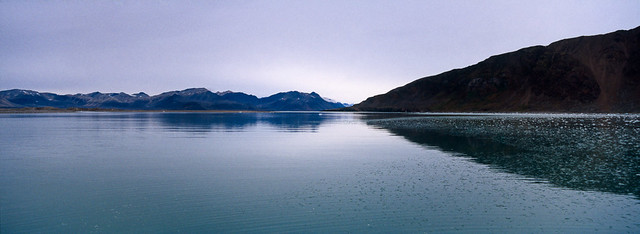
2010: Svalbard
Many XPan owners have a preference for a particular lens, usually the 45mm or 30mm. I’m more equal opportunities - I find all 3 lenses to be excellent, and of the three I actually prefer the 90mm for landscape use, although I’ll admit that for street it is less adapted. I’ve owned two copies of the 30mm lens, and both have come down with so-called “Schneideritis” even though it is not a Schneider lens. Possibly there is a related Fujinonitis strain. My first one was replaced (somewhat reluctantly) by Hasselblad for this very reason. The replacement soon came down with the same symptoms. However, there is absolutely no impact on the optical behaviour of the lens, and it doesn’t seem too be contagious, so I just ignore it. Another blight to strike the 30mm lens, or rather its viewfinder, is the bubble level drying up. This is annoying, but it seems quite common. I have contacted the French Hasselblad specialists “Les Victor” about a repair, apparently they can fix it at a reasonable price.

2011: Stromboli
One of the first issues to hit XPan users is of course, how to actually deal with the output. In the early days, Hasselblad (I suppose) promoted the format to a network of labs which could print the panoramic format, and supplied sheets of special stickers in the camera box which could be fixed to the film canisters to indicate to the lab that they contained XPan frames. I know I had my first XPan roll lab printed, probably by Jessops pro shop in Oxford Street, London, where I bought it, and probably on the day I bought it. But from then on, pretty much it has been the hybrid route for me: lab developing, home scanning, home printing. I don’t think I’ve ever shot a roll of traditional black and white film in the XPan, only colour negative, colour positive and Scala. Maybe a few rolls of Polaroid instant film too.
2012: Switzerland
To start with, scanning XPan film at home was tricky. Unless you were basically a millionaire, there were no film scanners that could take anything other than standard 35mm frames, and flatbed scanners outside of the unattainable Linotype-Hell or Scitex were hopeless. So initially, using a Microtek 4000 scanner, I painstakingly scanned each frame in two halves, and merged them in Photoshop. Even with a high end Mac, this was tedious. So the barriers to entry were actually pretty high, and the XPan was very much considered a professional’s camera. Gradually things got easier. Just about affordable Medium Format desktop scanners emergec from companies such as Polaroid, Microtek, Nikon and Minolta, several of which specifically handled 35mm panoramic format, and I eventually settled on a Minolta MultiScan Pro which lasted me over 10 years. When after these years of service it started getting troublesome, I finally replaced it with a Plustek Opticfilm 120, which has been efficiently devouring both XPan and medium format film ever since. I thoroughly recommend this scanner, by the way.
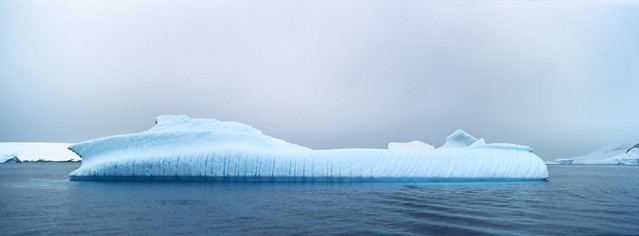
2013: Antarctica
It’s been a long journey with this camera, and although the current valuation (based on eBay) sometimes makes be think of selling it and using the proceeds to buy a small island, I’m not done with it yet. After all, I’m still waiting for my rolls of Film Ferrania slide film, not to mention new Ektachrome, to put through it. As an aside, Ektachrome 100G was the film that really made the XPan sing for me. At present I have to use Provia 100F, not a great hardship, but back in the days when there was choice, it wasn’t always the film I reached for.
2014: Sardinia
2015: Norway
So, should you buy an XPan today? Frankly, at eBay prices, no. It’s not worth it. The camera has crossed the border from “working tool” to “sought-after collectible”. Get a Fuji GSW690 and crop. Or use a digital camera with suitable framing, such as the Sigma dp0 (my candidate for the “digital XPan”). So far, fingers crossed, unlike several other electronic film cameras, the XPan is not displaying any chronic failures that I know of, but they will come, and it will not be repairable. So paying crazy money like $6000 - $7000 for a so-called pristine model on eBay is very unadvisable in my opinion, not to mention well over $1000 for a non-working body. In particular the markup on XPan II bodies is absolutely not justified from any photographic point of view.
If you do find one which is more realistically priced because it isn’t collector-pristine, bear in mind that any XPan body actually used for photography will inevitably acquire scuff marks and paint chips, and this is not an indication of over-heavy use. Although note, the extreme beaters you sometimes see on eBay do surprise me. My camera is not mollycoddled at all, so to get it in the beaten up condition of some I’ve seen must take real dedication. Having said that, I do remember in 2004 seen an XPan belonging to US landscape photographer Steve Kossack practically stripped of paint, so I guess it is feasible.
2017: Switzerland
Up to a few years ago you could still buy good used models with a warranty through reputable second hand dealers, but that supply seems to have dried up. Who is going to trade in their camera to a dealer for maybe $1000 when $3000 on eBay is now considered “cheap”?
2018: Calabria
The XPan has acquired mythological status. Personally, to a great extent, it defines me as a photographer, but that’s because of circumstances. I happened to be in the right place at the right time, with adequate cash, to get in at the ground floor. But it is only a camera. Today, there are other paths to follow, and plenty of other ways to pursue “widescreen” photography. If you happen to come across an XPan in fair condition with no bits missing for under $2000, then go for it. Otherwise, be sure you know what you’re getting into!
More of my XPan photography:
More XPan reading:



